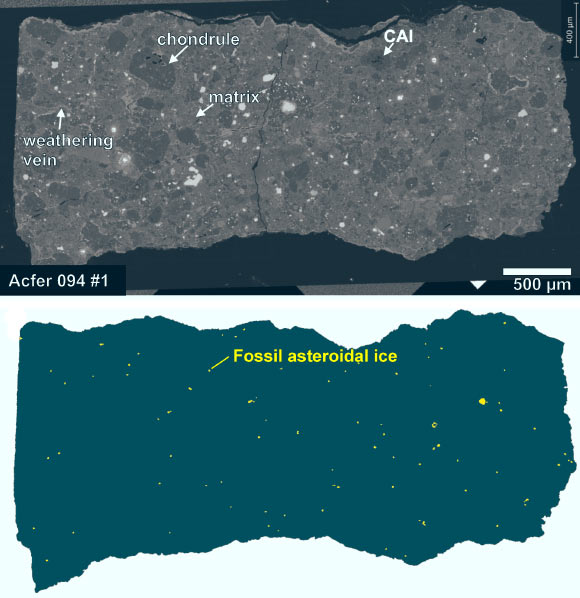An international team of scientists from the UK and Japan has found ‘fossilized asteroidal ice’ and pristine dust materials in a 4.6-billion-year-old meteorite called Acfer 094. The discovery is further evidence that when early asteroids formed they incorporated frozen water into their matrix.

SEM image of the Acfer 094 polished section and its illustration show that fossil ice (colored in yellow) is widely distributed in the meteorite. CAI – Ca-Al-rich inclusion. Image credit: Matsumoto et al, doi: 10.1126/sciadv.aax5078.
Acfer 094 is a carbonaceous chondrite that was recovered in Algeria in 1990.
Whilst this space rock has been studied previously, its matrix, which is the material holding the meteorite together, was overlooked.
Due to the fine-grained state of the matrix the technology needed to investigate it further simply did not exist. Recent advances, however, have allowed researchers to return to Acfer 094 and study it in more detail than ever before.
“Acfer 094 dates to roughly 4.6 billion years ago, when the Sun was born and our Solar System formed,” said senior author Dr. Epifanio Vaccaro, a scientist in the Department of Earth Sciences at the Natural History Museum, London.
“The matrix of such meteorites is thought to be the starting material from which all the planets formed.”
The presence of water within asteroids has been hinted at previously by observed changes in their mineral make up, now known as aqueous alterations.
But how this water was distributed throughout the asteroids, and when this ice melted has not previously been understood.
By looking at the fine structure preserved in Acfer 094, Dr. Vaccaro and colleagues were able to see the microscopic pockets that were left behind when the ice they once contained melted. These tiny holes that record where the ice once was are known as fossil ice.
The discovery allowed the team to create a model that tells us how the parent asteroid of Acfer 094 grew and how the planets formed.
“The parent body grew by agglomeration of fluffy source dust with and without ice through its radial migration from the outer to the inner regions of the Solar Nebula across the snow line, a point in the planetary disk beyond which water ice can exist,” the scientists said.
“The process produced a layered structure inside the parent body, with an ice-rich core and an ice-poor mantle.”
“Around the snow line, ice-bearing porous regions were incorporated into the mantle.”
“Subsequently, the melting of ice, mainly in the core, induced an aqueous alteration in the parent body.”
“Acfer 094 was subsequently ejected from the mantle of the parent body by some destructive processes.”
More advanced technology will now allow researchers to look back and re-examine previously discovered specimens.
It is hoped that through understanding how these primitive asteroids came into being we will better understand where we ourselves come from.
“They are made up of very similar stuff from which our own planet is formed, so by studying these meteorites we can better understand how the Earth evolved,” Dr. Vaccaro said.
The findings were published in the journal Science Advances.
_____
Megumi Matsumoto et al. 2019. Discovery of fossil asteroidal ice in primitive meteorite Acfer 094. Science Advances 5 (11): eaax5078; doi: 10.1126/sciadv.aax5078







